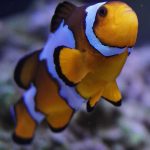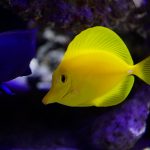Aquarium Chillers
In the past, not that many hobbyists needed or wanted chillers on their life support systems, as they tend to be expensive, noisy and create a lot of heat. Plus, unless they owned a system with temperate animals or they owned a reef system located in a room where temperatures ran higher than 83 or more degrees, they didn’t need the additional expense or maintenance of a chiller. Much has changed in recent years and we are seeing more and more chillers on our clients’ systems. Hobbyists are becoming interested in temperate fishes and invertebrates and reefkeepers are realizing the benefits of having this type of temperature control.
How Chillers Work
Aquarium chillers work like the refrigerators in our homes and offices, i.e., they maintain temperature by removing heat from the system. If you swipe an alcohol swab over your skin, that patch of skin feels cooler as the alcohol evaporates and removes heat from your skin. That’s a bit of an oversimplification but the principle is pretty much the same.
There are five main components of a chiller:
- The heat exchange coil
- The compressor
- A large fan
- The condenser
- The expansion valve
How They Work:
- As aquarium water passes through the heat exchanger, it flows around coiled pipe that has liquid refrigerant flowing through it. The cooler temperature of the coil removes heat from the water and transfers it to the refrigerant.
- The warmed refrigerant then goes to the compressor, which compresses it, changing it from a liquid state into a gas.
- The refrigerant gas then proceeds to the condenser, which looks like the radiator on an automobile. The large fan pulls air through the condenser, which cools the refrigerant as it passes through the pipes. The fins of the condenser make it easier for heat to leave the system. As the refrigerant cools, it becomes a liquid again.
- Before the liquid refrigerant passes through the heat exchanger again, it goes through an expansion valve, which controls the pressure inside the refrigerant piping, controlling how quickly the refrigerant goes through the condenser and heat exchanger. This controls how quickly aquarium water is cooled and helps prevent the heat exchange coil from freezing solid.
A chiller’s performance is governed by a temperature controller, which acts as a type of electrical gatekeeper. In some models, the temp controller is built-in and is governed by a sensor inside the chiller. In larger, professional models, the temp controller is a separate component that the chiller is plugged into. A sensor is usually placed somewhere securely in the display tank. If the water temperature in the display goes above the parameters programmed into the temp controller, electricity passed through the controller to the chiller, which removes heat until the target temperature has been reached.
Proper Installation
Although there are chillers that have drop-in heat exchange coils that can be added to the sump of a system after it has been plumbed, planning for and plumbing a chiller into a life support system when it is built is by far the better option. When plumbing a chiller, it is best located after the mechanical, chemical and biological filtration, so that waste, uneaten food and other debris are removed before they can impair the performance of the heat exchanger.
Chillers are also best located in an area with good ventilation, so that the heat the chiller emits can quickly dissipate into the room. As we mentioned, chillers produce a lot of heat and noise, so they are best located in a separate room, although that is not always practical.
Regular maintenance is essential for maintaining the performance of a chiller and extending its useful life. The single most important bit of maintenance you can perform is pretty easy; when the chiller is off, take a brush and vacuum cleaner and gently brush the accumulated dust, lint and other debris and vacuum it from the condenser fins. This allows the chiller to “breathe” far more easily and makes a big impact on how efficiently it removes heat. An unmaintained condenser quickly clogs, making the compressor run a lot more and at higher temps, dramatically shortening the lie of the most expensive component.
Professional, Reliable Aquarium Maintenance Services for Portland Area Clients
If you would like a professional aquarist to help you choose the right chiller for your life support system and then install it and maintain it for maximum return on investment, call us today at 503.784.4403 and schedule a consultation. We will be happy to discuss the different options that are available and help you select the chiller that is best for your system and budget. We can then install the chiller and regularly maintain it as part of our regularly scheduled aquarium services. For more information about aquarium chillers and how they might benefit your system and animals, call us today and let our experience be the catalyst to a stunning display in your home or business.





